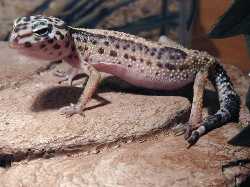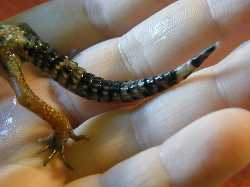Leopard Gecko Health
This page is intended to give information regarding health problems that leopard geckos may experience. I am not a vet and therefore will not be providing treatment information. If you suspect that your reptile has a health problem you should seek the advice of a qualified reptile vet. The information on this page is the result of knowledge I have gained through reading other care sheets and books, discussions on various web forums, veterinary advice and my own experiences with leopard geckos. This information represents what I have personally found useful and interesting.
Selecting your leopard gecko
When buying a new leopard gecko you should select one that looks healthy and is lively when handled (babies/juveniles should be quite flighty when handled, whereas the adults may be more tolerant of handling but should still be responsive). You should be looking not only at the leos general condition, but also at the conditions in which it is kept (as these will give you an idea of how it has been cared for previously and whether the conditions may have affected its health). If any of the cage mates look ill, it is possible that the ones that "appear" healthy are also affected, so it is best to only select a gecko from a shop/breeder in which all the animals look healthy and well cared for.
Healthy leopard geckos
- should be alert when handled.
- tails should be full and plump (not dehydrated, as in the photo below).
- bodies should be reasonably plump (bones should not be visible).
- stomachs should be rounded and full, but not distended (unless it is a gravid female) or showing signs of internal bleeding/bruising.
- skin should appear healthy ("sweating", open sores, blisters, strange discoloured areas, signs of infection and dehydrated looking skin are indicative of a problem) and without mites and/or ticks.
- eyes should be bright and clear (there should be no swelling, discharge or dried residue).
- mouths should be firm and clean without discharge.
- noses should be clean, dry and without discharge.
- limbs and jaw should be firm (not flexible/bendy). If the jaw/limbs are bendy this would indicate MBD.
- toes should be complete (5 toes on each foot) and without unshed skin, bleeding, swelling or signs of infection.
- vent area should be clean and without prolapsed organs.
- feces should be solid, black or brown, with whitish urate (diarrhea or odd coloured stools are indicative of a problem).
Only select a leo that has been kept in a tank that is clean and free of excrement. The leo should have access to a water dish (containing clean water) and a humid hide.
The photos below show ill leopard geckos. The photos courtesy of Toby show Pepper, who made a full recovery.
|
|
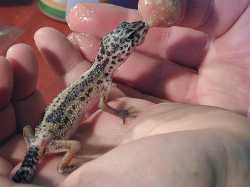 (Image courtesy of Toby) |
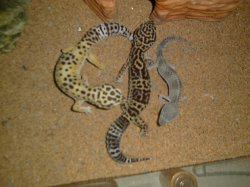 (Image courtesy of Heather) |
Notice Pepper's sickly looking skin, thin legs, skinny dehydrated tail and general ill appearance. The bottom left photo shows Pepper being handfed a nutritious mix to sustain her whilst she showed no interest in livefood.
Leopard geckos are one of the most hardy reptiles, and with proper care most problems can be avoided. A few problems which may arise include:
Shedding problems
Failure of leopard geckos to fully shed can be due to a lack of access to a moist environment during shedding. Unshed skin is particularly common around the snout, toes and eyes, and should be removed as soon as possible. If ignored, unshed skin can lead to a number of more serious problems such as infections, eye problems, and loss of toes (unshed skin restricts the blood flow to the toes). Unshed skin can be removed by letting the animal soak in warm water for about 10 mins then gently rubbing the unshed skin with a wet cotton bud until the skin comes off, this may take several attempts. Unshed skin should never be forced off, this may damage the leos skin, leaving it open to infection. Shedding problems can be avoided by providing a moist hide and ensuring that it is always moist. If infections arise, a vet should be consulted, and the substrate should be changed to papertowel until the infection is cleared up.
Tail loss
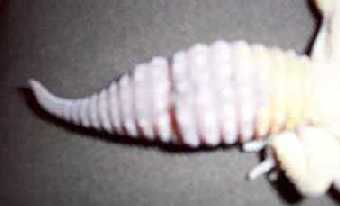 When
a leopard gecko feels threatened, or is grabbed by the tail, it will drop
its tail as a defense mechanism (the tail will wiggle on the ground, and
hopefully act as a distraction to the threat while the gecko makes its escape).
This process is known as autotomy and is a defense mechanism possessed by
several gecko species. The connective tissue of the tail is specially adapted
to allow the tail to break off at determined fracture planes, these fracture
planes are spaced along the length of the tail. The photo on the right shows
the tail of a leopard gecko which is presumably "fractured" at
one of these fracture planes- in this instance, however, the tail did not
break off, instead it healed.
When
a leopard gecko feels threatened, or is grabbed by the tail, it will drop
its tail as a defense mechanism (the tail will wiggle on the ground, and
hopefully act as a distraction to the threat while the gecko makes its escape).
This process is known as autotomy and is a defense mechanism possessed by
several gecko species. The connective tissue of the tail is specially adapted
to allow the tail to break off at determined fracture planes, these fracture
planes are spaced along the length of the tail. The photo on the right shows
the tail of a leopard gecko which is presumably "fractured" at
one of these fracture planes- in this instance, however, the tail did not
break off, instead it healed.
When the tail (or part of the tail) is autotomized, the nerves go through
a process called vasoconstriction- this process stops the blood flow to the
open part of the tail, thereby preventing the wound from bleeding. The tail
will grow back in time, however, it is unlikely to resemble the original.
tail wound
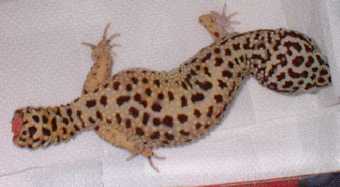 If
your leopard gecko drops its tail (as shown in the photo opposite, photo
courtesty of Helen), it is important to determine the cause and make sure
that the gecko will no longer be stressed. The wound may heal without requiring
treatment since the tail is designed to break off, however it can be treated
with neosporin to prevent infection. Leos that have dropped their tails should
be kept singly (to avoid further stress and competition for food) on clean
kitchen towel (to avoid infection of the wound), in a quiet environment.
Tail loss results in the loss of the stored fat reserves, therefore it is
important to offer tail-less leos as much quality (i.e. well gutloaded) food
as they can eat. However, any uneaten crickets should be removed from the
tank to prevent them nibbling on the tail wound.
If
your leopard gecko drops its tail (as shown in the photo opposite, photo
courtesty of Helen), it is important to determine the cause and make sure
that the gecko will no longer be stressed. The wound may heal without requiring
treatment since the tail is designed to break off, however it can be treated
with neosporin to prevent infection. Leos that have dropped their tails should
be kept singly (to avoid further stress and competition for food) on clean
kitchen towel (to avoid infection of the wound), in a quiet environment.
Tail loss results in the loss of the stored fat reserves, therefore it is
important to offer tail-less leos as much quality (i.e. well gutloaded) food
as they can eat. However, any uneaten crickets should be removed from the
tank to prevent them nibbling on the tail wound.
Tail loss can be the result of bullying between tank mates. Often the signs of bullying are not obvious to the owner, as the bullying can take place at night when the owner is not about. Leopard geckos can and do bully each other by biting. I have personally witnessed one leopard gecko biting another ones legs when she went near the shared food dish. However, most often the first point of "attack" is the other leos tail- often this is where the first signs of bullying can be observed (see photo below), and this can lead to the loss of the tail. A tell-tale sign of bullying on the gecko in the photo below are the scuff marks on her head (click on her head for a close up), along the body and tail- a mouth-shaped bite mark can also be seen on the tail.
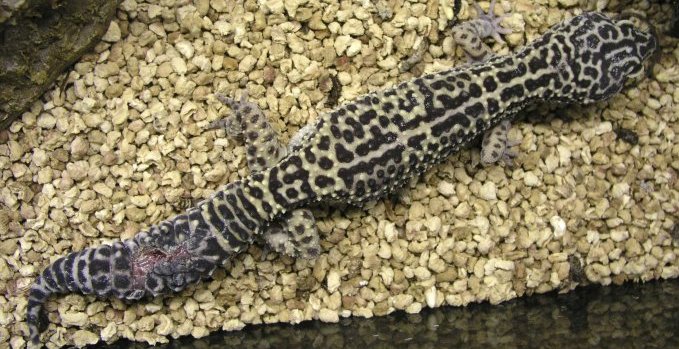
Loss of appetite
Loss of appetite, or maybe more accurately, lack of interest in food is quite common in leopard geckos. It can have a number of causes. It is quite common for leopard geckos to reduce their food intake over the colder months, some even enter into brumation (reptile equivalent of hibernation) and eat virtually nothing. So long as the gecko has a fat healthy tail this should be nothing to worry about. Should the gecko lose significant weight, particularly in a short period of time, a vet should be consulted. A number of leopard gecko ailments could cause such a lack of appetite, however likely causes could include parasites.
Regurgitation
Baby leopard geckos can regurgitate food if they have eaten too much, they should likely only do this once, and learn not to eat so much next time! If the leo continues to regurgitate food it should be taken to the vet. Any undigested matter found in the tank could be regurgitated food, however, it could also be undigested food which had been passed. Regurgitation (especially when associated with weight loss, dehydration and lethargy) could be a symptom of a number of health problems, it could be due to impaction, however the prime suspect would be parasites, the leo should be examined by a vet.
Diarrhea/loose stools
Feces can differ in consistency depending on the type of food that the gecko is eating, and the amount of water it drinks. However, feces which are watery, loose, contain undigested food, or particularly if they contain blood or are green are indicative of a problem. Other symptoms which can be associated with abnormal stools are lethargy, parasite infestation or a bacterial infection. Geckos with abnormal feces should be taken to the vet, ideally a fecal sample should be examined, by the vet, for signs of parasites or bacterial infection.
Skin infections
Skin infections can be the result of damp/soiled substrate, such skin infections would particularly affect the stomach since it is in contact most with the substrate. Skin infections around the stomach may appear as brown/black dots. Skin infections can also occur anywhere that skin has been damaged/broken (e.g. if the gecko damages its snout or has problems shedding). Toes are particularly prone to infection, both through damp/soiled substrate and due to shedding problems. If an infection is suspected it is best to seek veterinary advice. Your vet will most likely advise that the gecko is kept on a papertowl substrate in a very clean environment (to help keep the infected area clean and promote healing) and may treat the infected area topically with betadine or neosporin/polysporin.
Eye infections
Eye infections are not uncommon in leopard geckos. Symptoms of an eye infection may include swelling of the eye, discharge from the eye, cloudiness of the eye, difficulty in opening the eye. Eye infections can be the result of any irritation to the eye (e.g. the leo may get dust in its eye from the substrate, or scratch its eye on something while hunting). In all cases, eye infections should be investigated by a vet. Most likely they will take a swab from the eye, culture from the swab, then they can determine the best method of treatment once the culture has been identified.
Mouth Rot
This is fairly rare in leopard geckos. It can result from either fighting, or if the animal bruises its snout against something. Symptoms include swelling of the jaw, loss of appetite and a discharge of pus from the mouth. A vet should be consulted, treatment may include cleansing the area with hydrogen peroxide and then swabbing with betadine or topical antibiotic. Severe cases may require antibiotic injection.
Respiratory infection
Respiratory infections are normally caused by exposure to excessively cool temperatures, which will result in a suppression of the immune system. Symptoms may include gaping mouth, difficulty breathing. Mild cases may be cured by increasing the temperature of the vivarium, however, a veterinarian should be consulted.
Impaction
Impaction of the gut can be caused by ingestion of substrate, ingestion of food that is too big, or by parasites. To reduce the risk of impaction animals can be kept on papertowel substrate, and food items should never be too large (no longer than 3/4 of the width of the geckos head). Accidental ingestion of substrate when the leo is hunting should not be a problem assuming they have only ingested a very small amount (and also assuming that a suitable substrate has been used). However, leos are known to eat the substrate purposely to get calcium- this can be avoided by supplementing their food sufficiently, you can even provide a small pot of calcium in the vivarium so the leo can regulate its own uptake.
Prolapse
The photos below show animals which have suffered a prolapse. Prolapse basically means that an internal organ or internal tissue is trapped outside of the body. Prolapse in leopard geckos occurs around the vent area. Tissues which could be affected by prolapse include the male reproductive organs (hemipenes) and the tissues of the lower intestine which lead to the vent. The problem of hemipene prolapse is mostly likely to occur following mating by the male. The lower intestines leading to the vent are used to transport fecal matter and eggs. Prolapse of the lower intestines is usually a result of the leo pushing (forcing) the lower intestines out of the vent (as a result of egg binding, impaction or parasites- which can cause a blockage in the intestine). Prolapse is obviously indicated by the presence of pink tissue extending (sticking out) from the vent. In such cases, the leo should be taken to the vet immediately, prolapse can be fatal. If a vet can not be reached immediately, the prolapsed tissue should be kept moist, by bathing it with a cool water solution containing sugar (if the prolapsed tissue dries out, it may have to be removed by a qualified vet). The sugar in the solution may help to draw out any fluid in the prolapsed tissue, thereby reducing the swelling making it easier for the tissue to be re-inserted (this re-insertion should only be carried out by a vet).
The photo below shows a prolapse in a bearded dragon (photo courtesty of James)
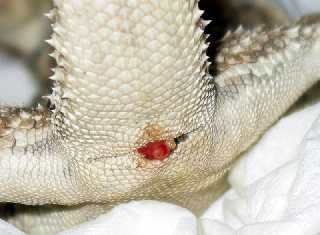
The below photos show an intestinal prolapse in a female leopard gecko (photo courtesty of Geckoville). The cause was identified as internal parasites.
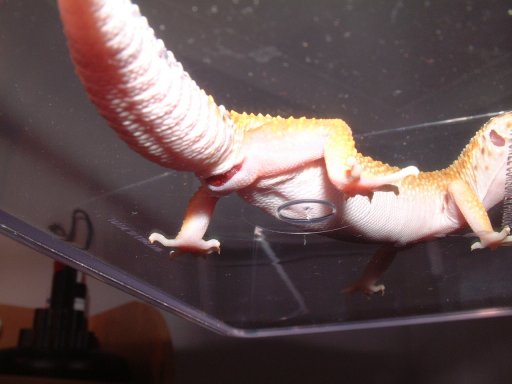 |
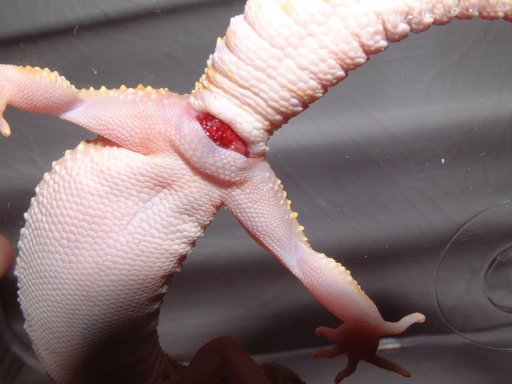 |
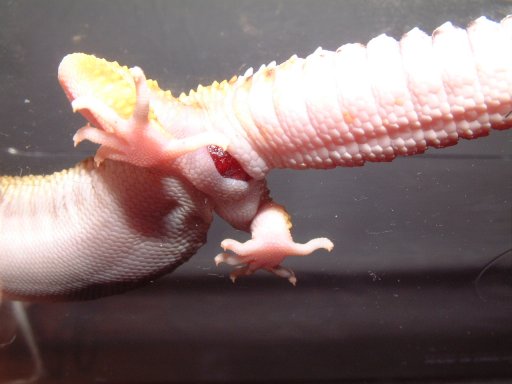 |
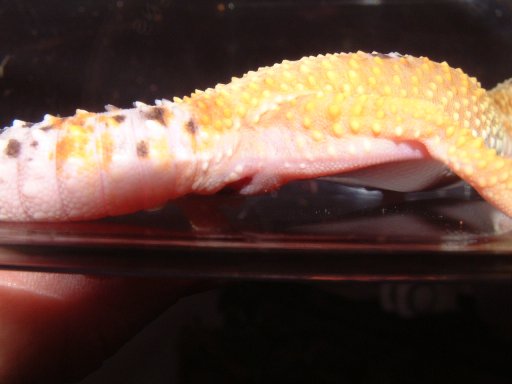 |
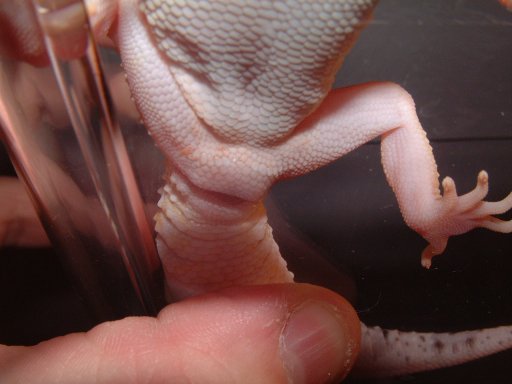 |
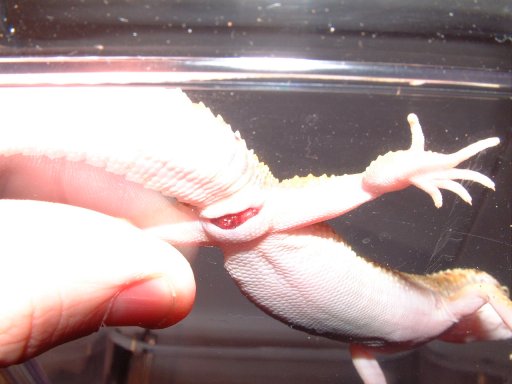 |
Egg Binding (dystocia)
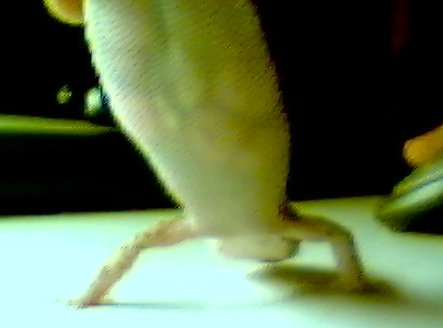 Female leopard
geckos sometimes fail to pass one or both of their eggs in a clutch, when
this happens the leo is said to be egg bound. When females are known to be
gravid, it is important to provide a suitable egg laying site for them (see
the breeding page). The substrate should be moist. Lack of access to a suitable
egg laying site may be a contributing factor to dystocia.
Female leopard
geckos sometimes fail to pass one or both of their eggs in a clutch, when
this happens the leo is said to be egg bound. When females are known to be
gravid, it is important to provide a suitable egg laying site for them (see
the breeding page). The substrate should be moist. Lack of access to a suitable
egg laying site may be a contributing factor to dystocia.
There are many different causes, and in most cases, the cause remains unknown. Any obstruction, or physical deformity of the oviduct or cloaca will prevent the eggs from passing through as normal. Other possibilies could be due to the eggs being too large, misshaped, or stuck together or could also be the result of a calcium deficiency (since calcium is an important component of the egg shell, and is also thought to induce the egg-laying contractions).
Symptoms of egg binding will include failure to lay eggs (note, however, that leopard geckos are also able to reabsorb their eggs, so failure to lay eggs is not necessarily a sign of dystocia). Dystocia should be not diagnosed unless you see the female straining, or it is obvious that she is very ill. An obvious sign of straining is prolapse of the cloacal or oviductal tissue. Other symptoms of dystocia can include lethargy, loss of appetite, bloated stomach, depression, non-responsiveness, weakness, straining (to lay eggs)- however, many of these are normal "symptoms" of being gravid too. Therefore, leopard geckos should be diagnosed with dystocia with care. The above photo (courtesy of Shawn) shows a leopard gecko that was treated with an oxytocin injection when dystocia was suspected, this injection however, resulted in the female producing multiple clutches of eggs which can be seen through the stomach wall.
In cases of dystocia a vet should be consulted, since it is a serious problem. Limited success (in egg bound females, successfully laying their eggs) has been seen with oxytocin injection, if this fails the eggs can be removed surgically- however, this is a very risk procedure.
Umbilical infections in hatchlings
Occassionally hatchlings can suffer from an infection of the umbilical area. Bacteria may enter the body via the area on the stomach where the yolk sac was attached. Symptoms may include a black spot/scab where the yolk sac was attached to the stomach, and/or watery stools, lethargy, and a general failure to thrive. Such infections are very serious, and veterinary treatment is essential.
Burns
| These photos (courtesy of Clara) demonstrate the importance of using appropriate heating equipment, ensuring that it is working correctly and continually monitoring the temperature your gecko is exposed to. The photos show Phoebe who was exposed to extreme temperatures when the thermostat failed to regulate the temperature of her heat bulb. As you can see, she is very badly burned, and sadly died as a result of her injuries. | 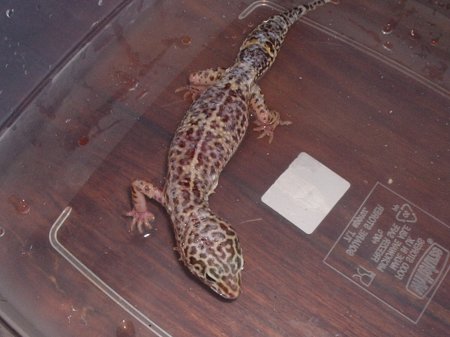 |
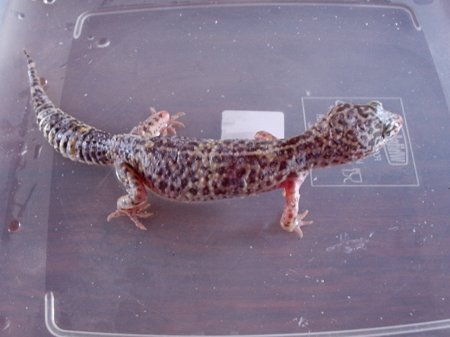 |
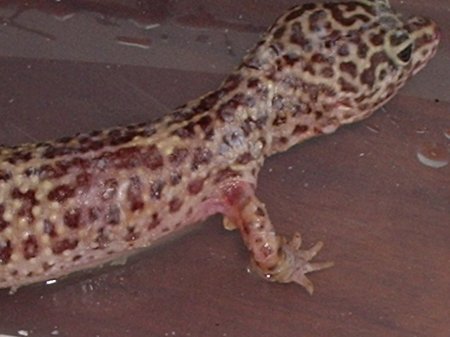 |
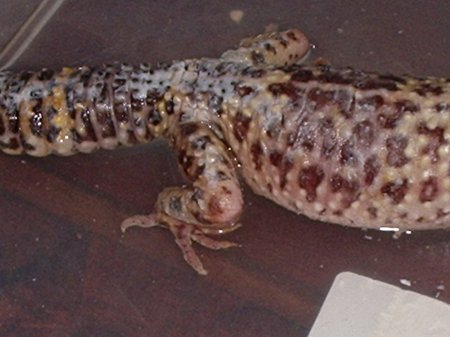 |
|
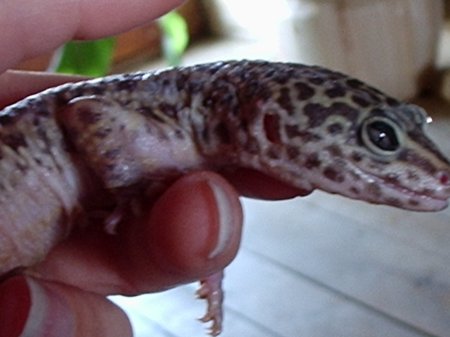 |
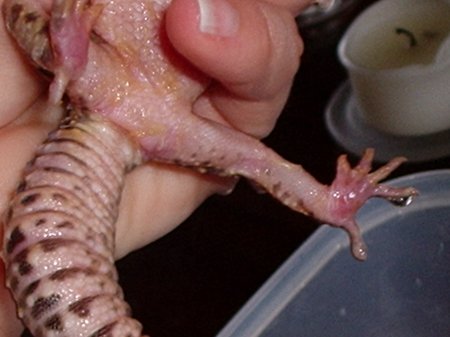 |
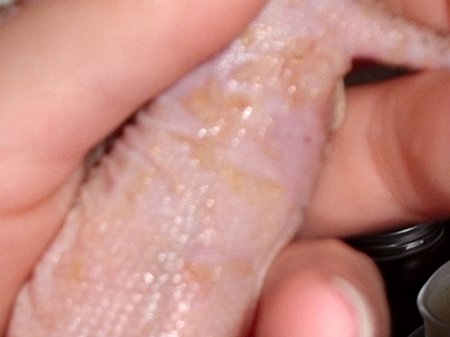 |
Eye problems in hatchlings
Occassionally babies hatch with eye defects. I have seen a few reports of babies hatching with eyes missing, eyelids missing, eyes sealed shut and various other eye deformities. It is thought, although I dont think proven, that this has been linked to a vitamin A deficieny in the adults.
Metabolic bone disease (MBD)
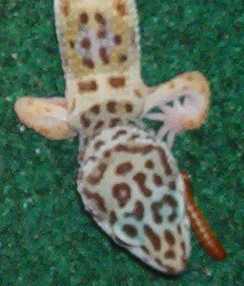 |
Signs of MBD include lethargy, distorted/swollen/rubbery/bendy limbs and/or a soft/flexible jaw. This disease results from a calcium deficiency. Note, this does not necessarily mean that there has not been enough calcium in the diet. Calcium uptake is regulated by a number of factors, an imbalance in the relative amounts of these factors can be the cause. Appropriate supplementation of the food should prevent MBD. A qualified reptile vet should be consulted should MBD be suspected, they will be able to advise if the problem can be corrected by supplementation or whether calcium injections are required. The photo on the left (courtesy of Dillon L) shows a young leopard gecko with MBD, note the typical distortion of the front limbs. |
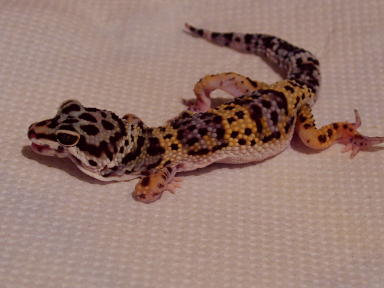 |
The photo on the left (courtesy of Missieren) shows a leopard gecko with serious MBD. The legs and jaw are very badly affected. Unfortunately this leopard gecko died despite treatment. |
Parasites
See the parasites page.

